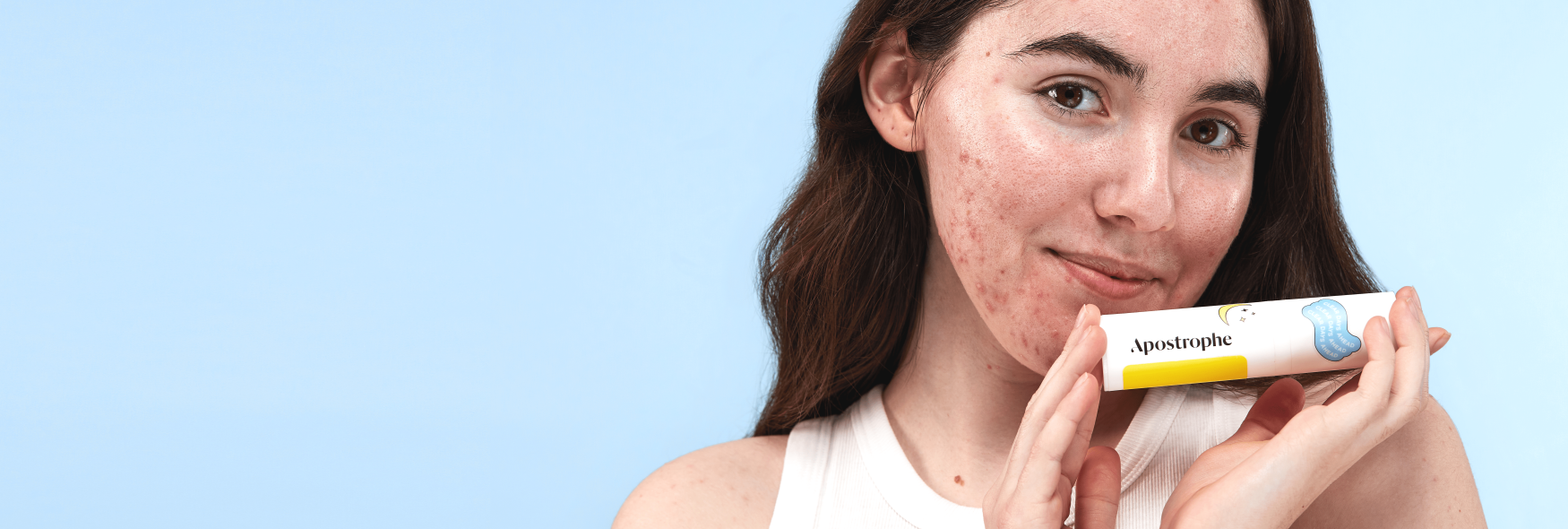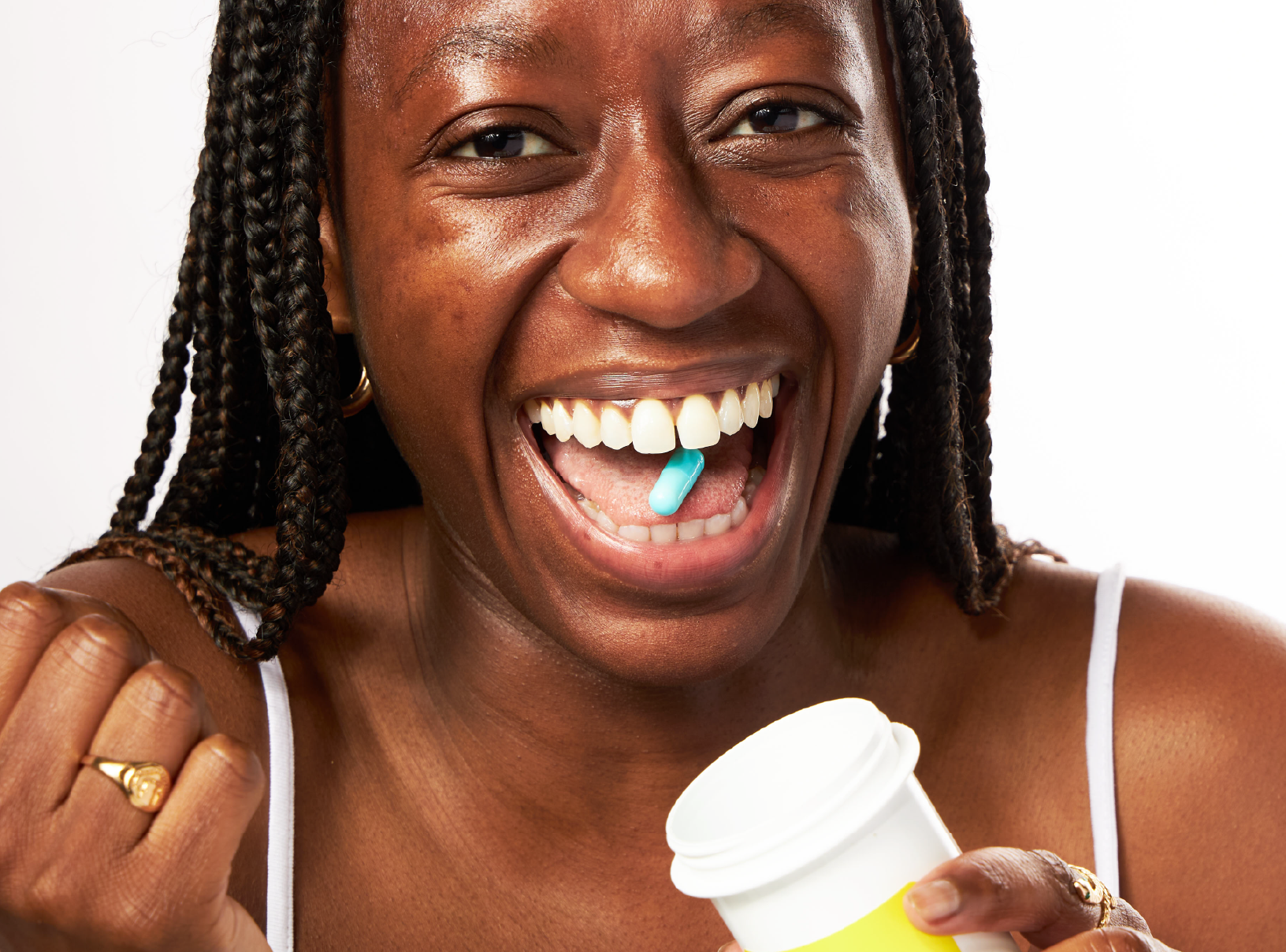Education
Salicylic acid for acne


SHARE
Education
Salicylic acid for acne
Medically reviewed by Mary Lucas, RN
Written by Apostrophe Team
Last updated 4/1/2024
You’ve seen it around: When it comes to over-the-counter acne treatments, salicylic acid is one of the most popular.
You can find this acne-fighting ingredient in everything from spot treatments to face washes and beyond.
Having this kind of over-the-counter topical acne treatment at the ready can help you act fast whenever one of those dreaded zits pop up.
But what exactly is salicylic acid — and how does it help heal acne? And are there any potential side effects? Read on for answers to these questions and more.
What Is Salicylic Acid?
Salicylic acid is a chemical that occurs in nature. It is a plant hormone that plays an important role in growth, development, and photosynthesis.
Salicylic acid is considered a keratolytic agent. This class of medication is used to break down the outer layers of skin and it is in a number of acne-fighting products.
Salicylic acid can also be manufactured, and when used on the skin, can act as an anti-inflammatory agent and exfoliator.
It also has antibacterial properties, limiting or killing certain types of bacteria.
Products containing salicylic acid typically offer it in a range of concentrations — often between 0.5% and 5%.
When you get into the higher range of the dose, you may need a prescription.
Salicylic Acid as a Treatment for Acne
To understand salicylic acid’s acne-fighting abilities, you need to have a general understanding of how acne forms in the first place.
Understanding Acne
A combination of sebum and build-up from dead skin cells can block your pores and hair follicles — which leads to acne.
Sebum is the oil-like substance produced by your sebaceous glands to lubricate your skin and hair.
Its other superpower is protecting your skin from bacteria and other harmful environmental factors.
But if you produce an excess amount of sebum, it can lead to pimples.
There are a variety of factors that can lead to excess sebum. For instance, hormone imbalances, like those that occur during your period, can contribute.
Genetic factors can also play a role in acne breakouts, as can environmental factors like overwashing your skin.
As previously mentioned, dead skin cells play a starring role in acne, too. Your body naturally sheds dead skin cells every 40 to 56 days as part of its process to renew and replace skin. This is called epidermal turnover.
The combination of dead skin cells and excess sebum can (as mentioned earlier) contribute to blocked pores and breakouts.
Using Salicylic Acid for Acne
Salicylic acid treats acne in a few different ways. Because it is an anti-inflammatory, it can help reduce swelling caused by certain types of acne — like papules and pustules.
As an exfoliator, salicylic acid sloughs away the outermost layer of skin (also called the stratum corneum). This helps remove the dead skin cells that can lead to pore blockages and acne.
By stripping away the top layer of skin, salicylic acid can also help to unclog pores. This can not just prevent but also help clear existing pimples.
Research also suggests that salicylic acid has antibacterial properties, which may help to prevent acne that is infected and inflamed.
Does Salicylic Acid Really Work?
The quick answer is yes, salicylic acid can be an effective way to treat acne.
A 2018 study of 24 women with mild to moderate acne incorporated the use of a 2% salicylic acid cleanser and cream along with a rebalancing gel.
The women who participated in the study experienced a significant reduction in several forms of acnes://www.apostrophe.com/slather/acne-types-causes-treatments/, including inflamed acne such as papules and pustules, and noninflamed, comedonal acne such as blackheads and whiteheads after eight weeks.
Another benefit noted in this study was that the use of salicylic acne may also have anti-aging effects.
There was also an older, 1981 clinical trial that involved medicated pads containing 0.5% salicylic acid used twice a day for 12 weeks.
At the end of that time, study participants noted a reduction in inflammatory acne and open comedones.
How to Use Salicylic Acid for Acne
There is a wide variety of over-the-counter acne products that contain salicylic acid — including face washes, creams, spot treatments, and toners, and they can be found virtually anywhere.
When you start using salicylic acid, you may notice a bit of dry skin or irritation. Because of this, it’s a good idea to start off treating smaller areas.
You may also want to consider starting with the lowest strength salicylic acid (usually 0.5%). This way, you can see how your skin reacts.
You should also be careful about getting it too close to your eyes, nose or mouth.
Finally, when using this topical treatment, don’t expect overnight results. In fact, your acne may look a bit worse before it gets better — especially if you have sensitive skin. Generally, you’ve got to give it at least a few weeks to work.
Salicylic Acid Side Effects
As with many acne-fighting treatments, there are potential side effects associated with salicylic acid.
The most common are skin irritation and stinging in the area where the salicylic acid is applied.
More serious side effects are very rare. These include:
Dizziness
Headaches
Confusion
Nausea
Hearing loss
Rapid breathing
Ringing in the ears
Extreme exhaustion
Diarrhea
If you experience any of the above while using salicylic acid on your skin, contact a healthcare professional as soon as possible.
If you notice hives, tightness in your throat, difficulty breathing, or swelling, seek help immediately.
More Ways to Treat Acne
In addition to salicylic acid, there are lots of other ways to treat acne — from over-the-counter options to prescription medications to natural solutions. Keep reading to review some of the most common acne treatments.
Topical Treatments
Along with salicylic acid products, there are a number of other topical treatments.
Benzoyl Peroxide: Like salicylic acid, benzoyl peroxide removes dead skin cells that may be clogging pores and kills bacteria that causes breakouts. It can also be irritating, so use it sparingly at first. Benzoyl peroxide and salicylic acid are often combined.
Retinoids: These help ensure pores stay clear by keeping dead skin cells from building up, and can also increase the rate at which your skin cells regenerate.Tretinoin is a popular prescription retinoid that works by encouraging skin to shed those pesky dead skin cells that cause breakouts.

PRESCRIPTION TRETINOIN
Target acne, dark spots, and signs of aging with this science-backed ingredient.
Clindamycin: A prescription topical antibiotic, clindamycin stops bacteria from multiplying.
Oral Medication
A prescription oral medication can also help diminish recurring zits.
Two of the most commonly prescribed oral medications include birth control pills and isotretinoin.
A few combined oral contraceptives have been approved by the FDA for use in acne treatment. These work by lowering levels of acne-causing hormones (like testosterone) and can reduce sebum production.
Isotretinoin also lowers sebum production and can prevent dead skin cells from building up, making pores less likely to get clogged.
It’s important to note that isotretinoin should not be taken if you are pregnant or could get pregnant.
Oral antibiotics are also sometimes prescribed for acne, to help prevent bacteria from multiplying.
Natural Remedies
Natural remedies (like tea tree oil!) may also help treat or prevent acne.
One study that was performed on 60 people with mild to moderate acne showed that applying a 5% tea tree oil gel was more than 3.5 times effective at reducing acne lesions vs. a placebo.
Green tea may also help — at least when applied directly to the skin. It is high in the antioxidant epigallocatechin-3-gallate (EGCG), which research has shown may fight inflammation and reduce sebum production. It may also prevent the growth of P. acnes in people with acne-prone skin.
There are also some essential oils that could help. More specifically, lemongrass, cinnamon, clove, lavender, and rose essential oils have been shown to potentially fight acne. Research has found these oils fight acne-causing bacteria S. epidermidis and P. acne.
Keep in mind that the research on essential oils and how they can help treat acne is still emerging.
Trying Salicylic Acid for Acne
For many, salicylic acid is an effective ingredient in the fight against acne. It’s also widely available and can be found in all sorts of skincare products — like face washes, spot treatments, and moisturizers.
Research has shown that salicylic acid can help treat inflammatory and noninflammatory acne in eight to 12 weeks.
It may dry out or potentially irritate your skin (like other topical acne products), so it may be wise to speak with a dermatology provider, to determine what’s best for you and your skin.
Sources
Dempsey, D., Klessig, D., (2017, March 23). BMC Biology, 23. Retrieved from https://bmcbiol.biomedcentral.com/articles/10.1186/s12915-017-0364-8
Keratolytic Agent, (2021). Comprehensive Dermatologic Drug Therapy (Fourth Edition). Retrieved from https://www.sciencedirect.com/topics/medicine-and-dentistry/keratolytic-agent
Salicylic Acid. National Library of Medicine. Retrieved from https://pubchem.ncbi.nlm.nih.gov/compound/Salicylic-acid
Acne (2012). Retrieved from https://www.womenshealth.gov/a-z-topics/acne
Makrantonaki, E, Ganceviciene, Zouboulis, C (2011, Jan-March). An update on the role of the sebaceous gland in the pathogenesis of acne. Dermato Endocrinology. 3(1), 41-49. Retrieved from https://www.ncbi.nlm.nih.gov/pmc/articles/PMC3051853/
Koster, M.I. (2009, July). Making an epidermis. Annals of the New York Academy of Sciences. 1170, 7-10. Retrieved from https://www.ncbi.nlm.nih.gov/pmc/articles/PMC2861991/
Arif, T., (2015). Salicylic Acid: a comprehensive review. Clinical, Cosmetic, and Investigational Dermatology, 8:455-461. Retrieved from https://www.ncbi.nlm.nih.gov/pmc/articles/PMC4554394/
Blaskovich, M., Elliott, A., Kavanagh, A., Ramu, S., Cooper, M., (2019, October). In vitro Antimicrobial Activity of Acne Drugs Against Skin-Associated Bacteria. Scientific Reports, 14658. Retrieved from https://www.nature.com/articles/s41598-019-50746-4
Jiang, L., Hino, P., Parker, L., et al. (2018, June). Efficacy and Tolerability of an Acne Treatment Regimen with Antiaging Benefits in Adult Women. The Journal of Clinical and Aesthetic Dermatology, 11(6): 46-51. Retrieved from https://www.ncbi.nlm.nih.gov/pmc/articles/PMC6011872/
Decker, A., Graber, E., (2012, May). Over-the-counter acne treatments. The Journal of Clinical and Aesthetic Dermatology, 5(5): 32-40. Retrieved from https://www.ncbi.nlm.nih.gov/pmc/articles/PMC3366450/
Salicylic Acid Topical. Medline Plus. Retrieved from https://medlineplus.gov/druginfo/meds/a607072.html#how
Acne: Diagnosis and Treatment. American Academy of Dermatology. Retrieved from https://www.aad.org/public/diseases/acne/derm-treat/treat
Tretinoin Topical. (2019, March 15). Retrieved from https://medlineplus.gov/druginfo/meds/a682437.html
Clindamycin Topical. (2016, October 15). Retrieved fromhttps://medlineplus.gov/druginfo/meds/a609005.html
Salvaggio, H.L. & Zaenglein, A.L. (2010). International Journal of Womens Health. 2, 69–76. Retrieved from https://www.ncbi.nlm.nih.gov/pmc/articles/PMC2971728/|
Isotretinoin. (2018, August 15). https://medlineplus.gov/druginfo/meds/a681043.html
Baldwin, H. (2020). Oral Antibiotic Treatment Options for Acne Vulgaris. The Journal of Clinical and Aesthetic Dermatology. 13 (9), 26–32. Retrieved from https://www.ncbi.nlm.nih.gov/pmc/articles/PMC7577330/
Enshaieh, S., Jooya, A., Siadat, A., Iraji, F., (2007, Jan-Feb). The efficacy of 5% topical tea tree oil gel in mild to moderate acne vulgaris: a randomized, double-blind placebo-controlled study. Indian Journal of Dermatology. 73(1):22-5. Retrieved from
Yoon, J., Kwon, H., et al. (2013, February). Epigallocatechin-3-Gallate Improves Acne in Humans by Modulating Intracellular Molecular Targets and Inhibiting P. acnes. Journal of Investigative Dermatology, P429-440. Retrieved from
Orchard, A., van Vuuren, S., (2017, May). Commercial Essential Oils as Potential Antimicrobials to Treat Skin Diseases. Evidence Based Complementary Medicine. Retrieved from
Like what you just read? Sign up for our email list to get the scoop on skincare science delivered straight to your inbox.

Education
What is milia?
What is milia? Today, we’re jumping into one type of bump that you may have heard about most commonly in infants — milia.
Read More
Education
Best moisturizer for acne-prone skin
If you have combination acne-prone skin, figuring out which moisturizer is best for your skin might be tough. In this guide, we break down the best moisturizer for combination, acne-prone skin.
Read More
Education
How to build a face care routine
As you get into skincare, it might seem overwhelming, especially trying to figure out the order you're supposed to apply products in. Below, we detail how to build a face care routine for your skin!
Read More
